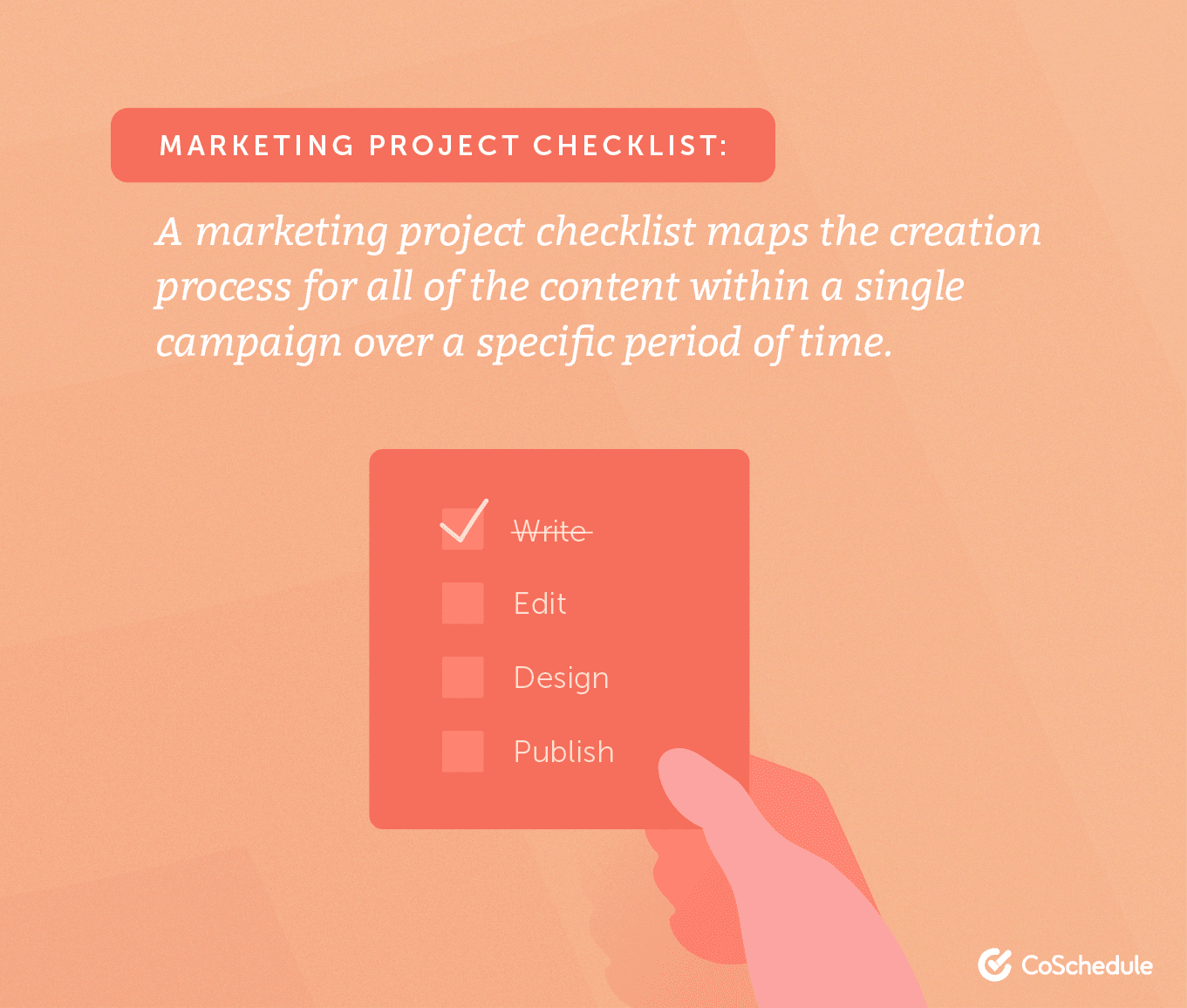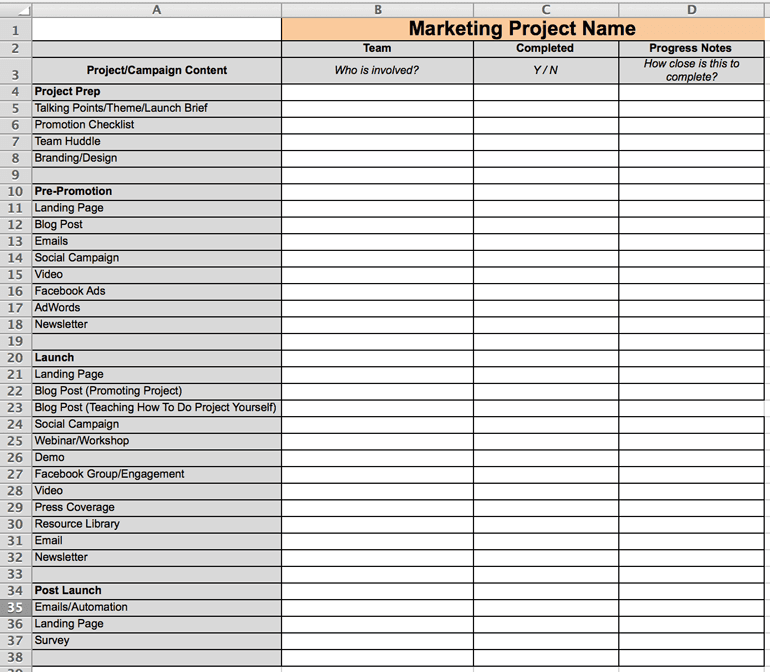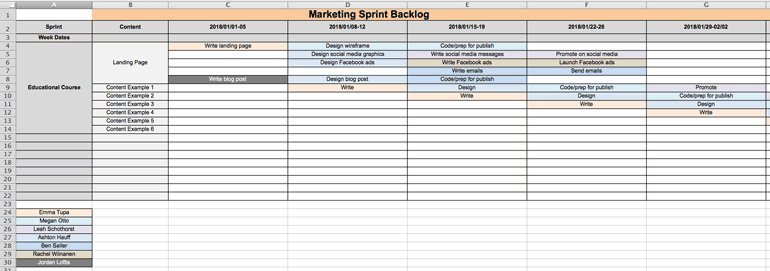Checklists are great tools for planning marketing projects.
In this chapter, you’ll learn how to build project checklists and timelines in your sprint backlog.
If your marketing timeline includes your high-level deadlines, this chapter deals with individual project-level planning on a more granular level.
[Tweet “How to create effective marketing project checklists.”]
Table of Contents
- What is a Marketing Project Checklist?
- Create Your Marketing Project Outline
- Map Your Content Development Process in Your Sprint Backlog
What is a Marketing Project Checklist?
A marketing project checklist maps the creation process for all of the content within a single campaign over a specific period of time.

The purpose of a marketing project timeline is to understand when to start working on a specific campaign to realistically set and achieve your deadlines.
This process also helps you understand the efforts used throughout your marketing team to execute specific phases of content development.
[content_upgrade_shortcode]
Create Your Marketing Project Outline
You defined your highest priority marketing project idea in Chapter 11 of this marketing strategy guide. The point of the Content + Promotion Checklist is to break down one project into all of the pieces of content you’ll create.
For example, if CoSchedule’s highest priority project is an educational course, our team may need to create the following content to make sure the project successfully influences our marketing goals:
- Launch brief and talking points: An internal document that explains the goal, target audience, what the project is, and how you’ll market the campaign.
- Brand brief: Since you’re creating multiple pieces, your designers may need a way to make sure the visual identity of the campaign is consistent.
- Signup landing page: This is the page where you’ll direct all promotional traffic.
- Lesson pages: These are the actual course material, and there will likely be multiple to create.
- Lesson videos: Some courses opt for visual content to include on every lesson page.
- Lesson quizzes: True courses teach, so you may want to quiz or test your students on every lesson page.
- Workshops: Most courses have some live action training that would include speaking points and a deck, like a webinar.
- Certificates: You may consider creating certificates for the students who pass all quizzes.
- Facebook group: This provides a way for students to collaborate and build community around your brand.
- Emails: You will promote the course to your email list. This will likely be more than one email to plan, write, and schedule.
- Social media campaign: You will share the course with all of your social media followers.
- Facebook ads: This is a way to reach a larger audience than those who already follow you.
In this example, you see how a large project breaks down into many pieces of content. You will do the same thing for your highest priority project.
Open the Content + Promotion Checklist tab in your marketing strategy template spreadsheet.

Column A already has some content ideas listed to help you kick-start your campaign planning process. Tweak as you see fit and add your own content ideas.
You’ll note column A is split into four distinct sections: Project Prep, Pre-Promotion, Launch, and Post Launch. Oftentimes, this helps with project timeline management because you know which pieces need to be completed before others. Again, if you find these categories aren’t applicable to your project, tweak the template as you see fit.
Add your content ideas to column A. In column B, write the team members’ names who will help you execute each specific piece of content.
Nearly any piece of content undergoes four phases during its development process:
- Write
- Design
- Code/prep for publish
- Promote
Think through the names of the team members who will complete each phase of the content development process to include in column B.
For example, this is who CoSchedule may need to involve to create the signup landing page of our educational course — just one piece of content in a much larger campaign.
- Write landing page: Austen Wageman, Product Marketing Copywriter
- Design landing page: Megan Otto, Web Lead
- Code/prep for publish: Megan Otto, Web Lead
- Promote on social media: Jayci Altenbernd, Social Media Intern
- Promote via email: Ben Sailer, Inbound Marketing Director
- Promote via Facebook ads: Jayci Altenbernd, Social Media Intern; Ben Sailer, Inbound Marketing Director
- Promote via blog post: Peyton Muldoon, Content Editing Intern; Ben Sailer, Inbound Marketing Director; Sam Weld, Graphic Design Intern; Tim Walker, Graphic Designer
This process will help you understand the level of effort into each piece and be able to map the project timeline, so no one is overwhelmed with too much on their plate at any given time.
Map Your Content Development Process in Your Sprint Backlog
Now, you’ll break down each piece of content into a phased development timeline.
Open the Sprint Backlog tab in your marketing strategy template spreadsheet.
In column A, write the name of your project. In column B, write the list of all the content you’ll create for that project. This is essentially the same list as your Content + Promotion Checklist.
For each piece, you can map when specific phases of content development will take place. Going back to CoSchedule’s landing page example, the timeline to create that single piece of content within the campaign may look like this:

Follow the same process for each piece of content within your marketing project. As you add more content, your sprint backlog becomes your comprehensive marketing project timeline.
Here’s what the project timeline example looks like for a single piece as we add more content into CoSchedule’s educational course:

Note that you can plan multiple sprints for multiple projects in the same Sprint Backlog tab in your marketing strategy template spreadsheet.
In this example, CoSchedule would simply write our second highest priority project idea in cell A15, then list our content involved in that project, starting in B15. From there, we’d map our project timeline following the same process we used from the first campaign.
Congrats! You’ve planned your first project, and you’re ready to execute!
The post How to Create Effective Marketing Project Checklists appeared first on CoSchedule Blog.



![Read more about the article The Beginner’s Guide to Product Photography [Tutorial + Examples]](https://www.dimaservices.agency/wp-content/uploads/2021/08/6040fd36-9eb7-4dca-9814-803df304b3c4-300x39.png)